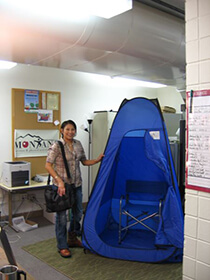
Outdoor job sites
Most types of agricultural and construction jobs are expected to grow in the next 10 years.1 Many types of agricultural jobs, such as graders and sorters, have a workforce that is more than 50% female.2 While only 3% of construction jobs are held by women, more than 250,000 women work in construction and may need lactation support.2 Women also work outdoors as installers, technicians, mechanics, or inspectors. View and share lactation break time and space success stories from outdoor job sites.
Lactation break time and space outdoors
Nursing moms who work outdoors need creative solutions for time and space to express milk. These can include mobile and temporary options that provide privacy, such as tents, portable lactation spaces, and vehicles. Helping a mother have direct access to her baby may also work in some situations. Non-exempt employees who are covered by the Fair Labor Standards Act (FLSA) must have reasonable break time and a private lactation space that is not a bathroom. The Break Time for Nursing Mothers FLSA requirement can be seen on the FLSA minimum wage poster (PDF, 147 KB) or notice that must be posted in worksites covered by FLSA.
- Time. Many employees use regular break times and meal periods to pump or express milk. Some companies do not track extra time needed during a pumping break, but some hourly workers clock out when lactation breaks take longer than standard break times. Many companies use floater staff to provide coverage when a worker must be away from her work station. Flexibility on the part of both employer and employee is necessary when a mother is breastfeeding. Supervisors should be aware of the need for lactation breaks if there is unscheduled overtime or extended duty hours.
- Space. While a mobile or flexible space such as a car, company van, farm vehicle, or a pop-up tent may not be ideal, these solutions might be the best way to accommodate breastfeeding employees in outdoor jobs. Employers may provide windshield visors or covers ×
 for privacy when the lactation space is a vehicle. Some companies have purchased new portable restroom shells ×
for privacy when the lactation space is a vehicle. Some companies have purchased new portable restroom shells ×  (with the toilet parts removed) to create a portable, clean, and private lactation space. An individual pop-up tent that is large enough for a chair and tall enough for someone to stand up in can be used outdoors ×
(with the toilet parts removed) to create a portable, clean, and private lactation space. An individual pop-up tent that is large enough for a chair and tall enough for someone to stand up in can be used outdoors ×  or in a larger common area indoors ×
or in a larger common area indoors ×  . All lactation spaces should have a place for an employee to sit down while pumping or expressing milk. Lactation space must not be in a bathroom. Learn more about what employers need to know about the Break Time for Nursing Mothers law.
. All lactation spaces should have a place for an employee to sit down while pumping or expressing milk. Lactation space must not be in a bathroom. Learn more about what employers need to know about the Break Time for Nursing Mothers law.
Lactation break time and space in construction, mining, and other outdoor job sites
Construction, mining, fishing, and other traditionally male-dominated jobs may require creative lactation break time and space solutions for female employees. Solutions can address common challenges, such as environmental, noise, or safety hazards, inflexible schedules for breaks, and limited space for milk expression. Worksites whose non-exempt employees are covered by FLSA must provide reasonable break time and a private lactation space that is not a bathroom. The Break Time for Nursing Mothers FLSA requirement can be seen on the FLSA minimum wage poster (PDF, 147 KB) or notice that must be posted in worksites covered by FLSA.
- Time. Many employees use regular break times and meal periods to pump or express milk. Some companies do not track extra time needed during a pumping break, but some hourly workers clock out when lactation breaks take longer than standard break times. Many companies use floater staff to provide coverage when a worker must be away from her work station. Women who work in hazardous environments where providing reasonable break time for expressing milk is not possible might need to be temporarily reassigned to different but equitable job duties while breastfeeding. Flexibility on the part of both employer and employee is necessary when a mother is breastfeeding. Supervisors should be aware of the need for lactation breaks if there is unscheduled overtime or extended duty hours.
- Space. Any job site with a main office that is located indoors might have temporary or flexible space for lactation. For example, an unused office or storage area can be used if it is private. Part of an indoor area can be screened off for lactation breaks. Some companies have purchased new portable restroom shells ×
 (with the toilet parts removed) to create a portable, clean, and private lactation space. An individual pop-up tent that is large enough for a chair and tall enough for someone to stand up in can be used outdoors ×
(with the toilet parts removed) to create a portable, clean, and private lactation space. An individual pop-up tent that is large enough for a chair and tall enough for someone to stand up in can be used outdoors ×  or in a larger common area indoors ×
or in a larger common area indoors ×  . All lactation spaces should have a place for an employee to sit down while pumping or expressing milk. Women who work underground or in hazardous environments might need to be temporarily reassigned to safer and equitable job duties while breastfeeding to minimize exposure to harmful chemicals or conditions. A lactation space must not be in a bathroom. Learn more about what employers need to know about the Break Time for Nursing Mothers law.
. All lactation spaces should have a place for an employee to sit down while pumping or expressing milk. Women who work underground or in hazardous environments might need to be temporarily reassigned to safer and equitable job duties while breastfeeding to minimize exposure to harmful chemicals or conditions. A lactation space must not be in a bathroom. Learn more about what employers need to know about the Break Time for Nursing Mothers law.
Sources
- Lacey, T. A., Toossi, M., Dubina, K. S., & Gensler, A. B. (2017). Projections overview and highlights, 2016–26. Monthly Labor Review. U.S. Department of Labor, Bureau of Labor Statistics.
- U.S. Department of Labor, Bureau of Labor Statistics. (2018). Labor Force Statistics from the Current Population Survey, Table 11: Employed persons by detailed occupation, sex, race, and Hispanic or Latino ethnicity.

